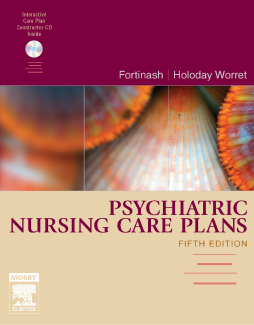
BOOK
Psychiatric Nursing Care Plans - E-Book
Katherine M. Fortinash | Patricia A. Holoday Worret
(2006)
Additional Information
Book Details
Abstract
The most comprehensive psychiatric nursing care planning text available assists students and practitioners in providing effective care in a variety of settings. Clear presentation of information, consistent use of the nursing process, correlation of nursing and medical diagnoses, and prioritization of interventions make this text an invaluable resource. Grounded in the latest classification of the Diagnostic and Statistical Manual of Mental Disorders (DSM-IV-TR) and the most current list of NANDA-approved nursing diagnoses, this text covers a wide range of disorders, their psychopathology, and appropriate nursing interventions with rationales. Care plans use real clinical situations and include therapeutic and nontherapeutic dialogue examples to familiarize nurses with likely scenarios and equip them with the tools they need to feel confident in any clinical setting.
- The first chapter, The Nursing Process, effectively describes the central principles of psychiatric nursing practice in detailing the ANA's six-step nursing process along with additional information on therapeutic nurse-client communication skills, client history and assessment tools, NIC and NOC, and more.
- The six-step nursing process format is maintained throughout to emphasize a practice-oriented, problem-solving approach to psychiatric care.
- Major psychiatric disorders are reviewed consistently and completely with sections including Etiology, Epidemiology, Assessment and Diagnostic Criteria, Interventions, and Prognosis and Discharge Criteria. With this basis of knowledge, relevant care plans are offered in the second section of each chapter.
- Care plans based on DSM-IV-TR medical and NANDA nursing diagnoses are logically and consistently organized with Assessment Data, Outcome Criteria, Planning and Implementation, and Evaluation sections.
- Assessment Data sections include detailed related factors (etiology) and defining characteristics or risk factors as appropriate for the specific diagnosis.
- Outcome Criteria sections give the reader clear indications of the desired end state.
- Planning and Implementation sections list specific, relevant, and practical nursing interventions with rationales in a clear, comprehensible two-column format. UNIQUE! Therapeutic and non-therapeutic dialogue examples are presented throughout to promote more effective client communication.
- Evaluation sections state the role of outcome evaluation as a critical and ongoing step in the nursing process.
- Client and Family Teaching boxes include Nurse Needs to Know and Teach Client and Family sections covering all aspects of post-treatment instructions for clients and caregivers.
- DSM-IV-TR boxes list all related DSM-IV-TR diagnoses for quick reference.
- Helpful appendices contain information and strategies that are timely and useful in the care of clients with mental and emotional disorders including such topics as psychiatric and psychosocial therapies, grief and loss, spirituality, and many more.
